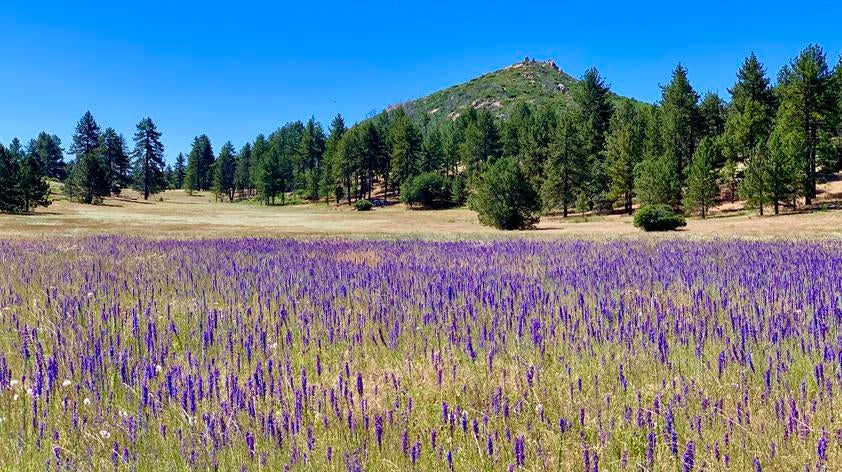
New species and living fossils – Part 2
In my last blog, I described how and why there came to be so many endemic species in our region. We have disproportionately large numbers of both paleoendemic and neoendemic species, which, I explained, was the result of past geological events and our varied ecosystem. To read that blog CLICK HERE.
2019 was an amazing year for our seed bank. A great rainy season at the end of 2018 and in the early months of 2019 resulted in bumper crops of seeds throughout our region. Through extensive planning and many miles hiking we added 80 new seed accessions last year, an all-time record for our seed bank.
In this blog I’ll highlight some of the rare endemic species we conserved last year, and discuss their evolutionary history and why their conservation is important.
Delphinium hesperium ssp. cuyamacae – Cuyamaca larkspur
One of my favorite memories from last year’s field season was discovering a large meadow filled with the sweet-smelling, tall spikes of these violet flowers. The buttercup family (Ranunculaceae) is ancient, originating over 100 million years ago in Eurasia. It is believed Delphinium arrived in North America just 3 million years ago and radiated quickly. There are around 30 different species in California (55 different taxa) today. The Cuyamaca larkspur evolved to grow in the higher elevation meadows found in San Diego County, and is known from roughly 30 occurrences.
Ericameria cuneata var. macrocephala – Laguna Mountains goldenbush
This compact shrub lives in the cracks of granite boulders and cliff faces on top of the highest peaks in the Laguna Mountains. Some of the best views we saw last year came while monitoring and collecting seeds from this amazing little plant. This genus is part of the sunflower family (Asteraceae), and radiated quickly as our climate shifted around 5 million years ago. There are around 23 different species (53 taxa) found in California today. The Laguna Mountains goldenbush is uniquely adapted to grow in exposed, windy areas at the tops of mountains, and is known from only 15 occurrences.
The species discussed above are examples of neoendemics that split from their closest relatives relatively recently as new niches opened in our ecosystem. We can think of neoendemics as new, quickly evolving, and full of potential. The ancestor for California’s delphinium, for example, evolved into 55 different taxa in just 3 million years, and evolution is still occurring! The subspecies and variety described above might – given enough time – evolve into new species all together.
But time might be running out. As the climate warms, species may need to migrate into higher elevations to find the conditions to which they are adapted. These two species already live at the highest elevations available in our region and will have nowhere to migrate.
If neoendemics are new, actively evolving, and full of potential, then paleoendemics are ancient, resilient, and full of history.
Tetracoccus dioicus – Parry’s tetracoccus
We targeted this species for years before the rains finally helped produce a good seed crop. This family (Picrodendraceae) is ancient, and spread around the world while the continents looked very different than they do today. The family originated in South America and spread into Australasia via Antarctica and into Europe and then Africa via the North Atlantic land bridge. Today, many genera in this family exist as relicts, with pockets of ancient species surviving around the world. It’s believed the genus Tetracoccus originated in the Americas over 60 million years ago. Today just 5 different species exist, all in the southwestern US and Mexico. Parry’s tetracoccus is known from roughly 50 occurrences in Southern California.
Pickeringia montana var. tomentosa – woolly chaparral pea
This is a very old, monotypic genus in the pea family (Fabaceae) that split from its closest relatives around 31 million years ago. The only extant species, Pickeringia montana, is one of my favorite chaparral species, and the variety tomentosa has tomentose (hairy) leaves. The flower on this shrub is bright magenta, and a beautiful contrast to the fuzzy grey leaves. It has large spikes on its branches, suggesting that it evolved alongside large herbivores like extinct North American rhinoceros, horse, and elephant relatives. Pickeringia is a relict, its range has been restricted as climate and topographies have changed over millions of years. The woolly variety is now rare and found only on the foothills of Southern California.
Paeonia californica (Paeoniaceae) – California peony
This beautiful native is not necessarily rare, but it is endemic to the California Floristic Province and has a fascinating evolutionary history. This genus originated in Eurasia and there are only 2 species found in North America. Research suggests the early ancestor migrated across the Bering land bridge into North America around 16 million years ago from Asia. Once isolated, two distinct species formed. Paeonia brownii is found from British Columbia south to the Sierra Nevada Mountains, while the California peony is found on coastal mountains in Central and Southern California.
It’s amazing to look around our diverse native plant community and consider the innumerable ways these different species came to be. As human advancement changes our climate at a quicker-than-natural pace, it’s the genetic diversity within these populations that will give plants the best opportunity to adapt and survive. Whether a neoendemic and freshly evolved, or a paleoendemic that evolved alongside dinosaurs, our seed collections ensure a plant population’s genetic diversity isn’t lost as they struggle to adapt to a world shaped by humans.













